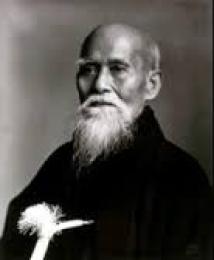Morihei Ueshiba
Morihei Ueshiba, or otherwise known as O'Sensei (Great Teacher) was born on December 14th, 1883, in the Wakayama Prefecture. In1902 Morihei fell under the influence of the eccentric scholar and environmentalist Kukamagusu Minakata. He inspired Morihei to contemplate the importance of seeing the world as an integrated whole, protecting the environment, while filling Morihei's head with the many wonders and challenges of the world, knowing he possessed the courage for these quests.
In 1901 he trained Tenjin Shi'Yo-Ryu Jujutsu under Tokusaburo in Tokyo. From 1903 to c. 1908 he trained Goto-Ha YagyuShingan-Ryu, under Masakatsu Nakai in Sakai City near Osaka. Thereafter, he trained Judo under Kiyoichi Takagi in Tanabe.
In 1912, O'Sensei moved to Hokkaido where he met and studied intensely under the renowned Daito-ryu master Sokaku Takeda. In 1919, in response to the critical illness of his father, Morihei returned to Tanabe, during which he encountered yet another great influence in his life, Onisaburo Deguchi, the leader of the flourishing religion Omoto Kyo. After the death of his father the following year, Morihei returned to Deguchi as a pious pupil for the next eight years. It was this same year Morihei opened his first dojo teaching Daito Ryu aiki-jujutsu, establishing it as the Ueshiba Academy.
In 1925, came the great enlightening for O'Sensei, a revelation that occurred after the defeat of a naval officer. This union of mind, body and spirit enabled him to understand the philosophical principles on which aikido was based. The transition of aiki-jujutsu (the martial art of aiki) now became aiki-budo (the way of aiki). By 1926, O'Sensei's art was growing rapidly in popularity and, he was often invited to teach the Admiral's Court at the Imperial Court. In 1931 he opened the Kokukan dojo. With the oncoming Pacific War in 1941, Morihei reestablished his headquarters in the Ibaraki Prefecture, and left the Kobukan in Tokyo in the hands of others. He had been purchasing land in Iwama since 1935, and now felt the need to preserve the spirit of Budo he had created for so many generations. He decided to reinstate the spirit of Aikido in the midst of Iwama for future generations.
It was here in Iwama that Morihei Ueshiba conceived the birth of the art now called Aikido. This inner sanctum of Aikido, as he so clearly described it, consisted of the Aiki Shrine, his home, and a dojo, all of which were completed in 1945.
After the completion of the Iwama dojo, O'Sensei spent the majority of his days training in that dojo with a young Morihiro Saito, Kisshomaru Ueshiba, koichi Tohei and Tadashi Abe. He would leave only for lectures and seminars, and occasionally lecture/classes at the Tokyo dojo, but nonetheless considered his place to be in the sanctum of Iwama. Although most of his time was spent in Iwama.
In 1960, Morihei was once again in the limelight of royalty as he was one of four martial artists to ever receive the Shijuhosho. This honorable award of achievement would be given to him by none other than the Emperor Hirohito.
In 1964, he again encountered the Emperor in the event of receiving another award in recognition of Morihei contributions to the martial arts.
On April 26th, 1969, at age 86, after the passing of O'Sensei death, the Japanese government bestowed it's highest honor declaring Morihei Ueshiba to be a Sacred National Treasure of Japan.

